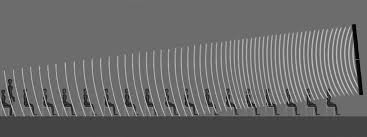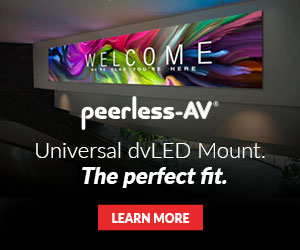by Rob Ziv | Jul 25, 2016 | Uncategorized
Improving Results with Column Line Arrays
I had a design inquiry come in this week for a sound reinforcement system. Nothing out of the ordinary; basic box of a room, 50 wide, 70 deep, 18’ ceilings, drywall construction, 13 rows of seats on a flat floor. The application is primarily speech reinforcement with the need to occasionally rock out. The designer had selected a fairly common pair of conventional speakers to place left and right in the front of the room. I was asked to take a look at the design just to be a second set of eyes. The speakers they selected would have been fine, but a column line array would have been a better option. While line arrays in general have become the de facto standard for touring sound systems and are common in large format installations, compact and column line arrays seem to be one of the most underutilized speaker configurations. The reason we don’t see more line arrays in small to mid-sized installations even when suitable, is due to several factors.
- Old habits die hard. Point-source systems (conventional speaker boxes) have been around longer.
- The benefits of line arrays are sometimes not fully understood. Some of the benefits include:
- Improved control over vertical dispersion. This minimizes reflections off of ceilings and other structural surfaces thereby improving intelligibility and system performance.
- While point-source speakers adhere to the inverse square law (where direct SPL drops by 6dB every time you double the distance from the source) line arrays only lose 3dB every time you double the distance – at least within the near field. What this means is you may not need to blast people in the front of a room for it to be loud enough to hear further back.
- In some cases, it is possible to aim the sound to target the specific requirements of various locations within a venue. While this is often not available within a compact column line array, it’s worth noting as it relates to line arrays in general.
- The detailed characteristics of line arrays are sometimes not fully understood. I would argue that this applies to point-source boxes as well. Yet there is greater familiarity and hence comfort with the point-source boxes. (See Factor #1 – Old habits die hard)
- Size matters. The longer the array, the tighter the vertical control and the lower the frequency where control is available. If a room is highly reverberant, the recommended height of an array may be significant compared to room height itself.
- End users ignore good audio and think they know what a speaker looks like. Audio is usually noticed most when something doesn’t sound good. So most people ignore the audio system when things are going right. Since column line arrays can sound better than their conventional counterparts in the right application and they do not always look like conventional speakers, most end users would not even know they have seen/heard a column line array unless it was specifically pointed out to them. In many installations, they blend into the architecture and can be less visually obtrusive than conventional boxes – even when stacked relatively high.

While line array technology has been around for at least fifty years, it would appear from the information above that hesitancy to adopt has more to do with education or experience and less to do with the technology itself. If you work in the installed audio market, consider taking a closer look at column line arrays.
For a quick start, consider the following case study within a highly reverberant House of Worship.
“A Bose Panaray System Tames the Reflections Inside the Thorncrown Chapel”
After that, take a look at some of the products on the market (for example, the Bose MA12EX cited in the case study.) We suggested the Bose MA12 with sub augmentation for the “basic box of a room” mentioned previously.
If you would like to learn more about column line arrays, shoot me an email and we’ll steer you towards additional resources.
by Rob Ziv | May 18, 2016 | Uncategorized
Why would anyone take a perfectly good desktop stand for a computer and throw it away? After all, the stand was included with the computer monitor and replacing it with another option will cause additional expense.
It may seem like a small thing. But for me it meant more space and greater productivity. I use a treadmill desk with a decent size work area – but no matter how I positioned my monitors, using the space was cramped.
Before:

I decided to try the Chief K1D220B dual monitor arms clamped to my desk. My thought was this would free up the space otherwise consumed by the stock monitor stand. It worked better than expected. Not only have I gained desk space, but now with the tips of my fingers, I can position my monitors at the exact height, distance, and angle that works in any given moment. I am less fatigued at the end of the day from poor monitor placement and I no longer struggle to get everything positioned on my desk. As an added bonus, I can keep my blinds open longer throughout the day as the sun no longer washes out my monitors.
It may seem like a small thing, but after using these fully adjustable mounts, I don’t want to go back to old way. The next step is to put these on my traditional desk at work and home. After experiencing the difference of using adjustable monitor arms, I can’t foresee ever using conventional desktop stands again.
After:

by Rob Ziv | Apr 20, 2016 | Education, Events, News

Wow; another E4 season is underway. There are so many things I enjoy about working the E4, from meeting great people, to sharpening technical skills in CTS RU certifies classes, to seeing new products up close with factory experts on hand to dig into the details. I look forward to E4’s every off-season and just wish they were longer when they do roll around. The kickoff in DC certainly did not disappoint. From a product perspective alone we saw a number of cool new items that are starting to make noise; some quite literally.
It’s not often a product creates a new market. This is exactly what Panasonic has done with their innovative Space Player. This was a huge draw at ISE in Amsterdam and the Almo E4 may have been the first time it appeared in public in the US. This highly anticipated little projector mounts to a standard lighting track and has built in SD Card slot and Wi-Fi for media playback. Being that it is about the size of a track lighting fixture, it is ideal of retail signage applications and flexible ambient techorating. Panasonic showed the unit mapped onto stationary products with active content highlighting the subjects. If you have customers looking for you to bring creative solutions, check out the video for further applications to get your imagination going. (Make sure to look for the butterflies in the restaurant.)
Another first for Almo were the ongoing live demos of the Bose F1 Flexible Line Array system. (My apologies to the 11AM Interactive E4 Experience…. perhaps we got a wee bit too loud with the EDM.) The venue’s octagonal room and dome ceiling certainly would have presented significant challenges for lesser systems. This self powered unit brings the advantages of line arrays to the portable market. Proving very popular in HOW, education, and performance spaces, the flexible vertical control makes it a great option in diverse setups and integrated systems, too.
QSC showed their super efficient Energy Star qualified SPA series of multi channel power amplifiers that provide up to 200 watts into low-z applications and 250W into 70V – and they fit in half a rack space. We’ll be hearing more about these amps as the word continues to spread.
Harman Professional brought their new interactive “virtual rack” to sit alongside their stacks of gear. This touch screen-driven self-guided demonstration allows attendees to dig deeper into many items from the extensive product families of JBL, Crown, dbx, and others. With product experts at their side, the virtual rack allowed attendees to experience a broader range of solutions than typically available on a show floor.
From the “you can teach an old dog new tricks” department, Chief brought along the new SYSAU Suspended Ceiling Projector System. “It’s just another mount” you say? Wrong! How about a system that includes everything you need for 90% of all projector installs – all in a single box. No more finding the right ceiling plate, length of extension column, trim ring, etc, etc. This makes spec’ing, quoting, and installing projectors faster – period. Plus, if you inventory mounting components, this will make life much easier. (Yes – another video.)
With so much to see and do, I’m sure I missed some of the highlights. Please share yours and I look forward to seeing on the next stop of the E4 AV Tour!
by Rob Ziv | Jan 15, 2016 | News
 What is the first thing that comes to mind when someone says the name Bose Professional?
What is the first thing that comes to mind when someone says the name Bose Professional?
Remember that thought.
Ironically, even when emphasizing the word Professional in the name, Bose has such a strong brand image that as member of the Pro AV industry, you still may have thought of a specific consumer product. If you are a typical end user reading this, you may have been thinking about a high end audio brand in general. Bose Professional may be one of the best kept secrets in the Pro AV market – and this has been true for almost 30 years. Those in the know realize that Bose Professional is comprised of diverse products that are designed and built specifically for the Pro AV market. These are not rehashed consumer units at all.
Bose professional division’s backing from the larger Bose organization certainly helps when it comes to providing R&D resources, along with testing and support. In a similar manner Lamborghini, Porsche, Bentley, Audi, and Bugatti all receive backing from their parent company. If you knew Volkswagen owns all these companies, would you now look at a Lamborghini Aventador, Porsche 911, Audi R8, or Bugatti Chiron and say they are just VW Beetles in disguise? Probably not.
Bose Professional’s research extends into both their products and their go-to-market strategies; with a focus on positive outcomes for the dealer/integrator and the end user. The decision to leverage the Bose name on the professional side of the company makes sales easier and increases the likelihood of favorable customer responses to proposals. Bose Professional’s installed products are not available online; reducing price shopping from customers. The portable products with limited online availability have strict MAP policies providing further protection. I have seen Bose go to great lengths to protect projects for dealers that specify their products for design build projects. The way Bose conducts business by itself makes them worthy of consideration for projects.
I remember being introduced to Bose Professional during the late 80’s when working for a Pro AV dealer / studio design company. It took me a while to look beyond Bose as the manufacturer of the then-popular Wave Radio, but I am glad I did. In retrospect, I understand why the pro division has stayed a secret for so long. Bose has become the competitive advantage offered by many dealers and they don’t want their competition to know. Until recently, Bose was only available via a restricted direct reseller program. Almo’s value added distribution model has earned us the ability to provide Bose Professional to qualified resellers.
There is a lot of value in the line from both a technical and business perspective. If you want to learn more, check out a replay of the webinar introducing the Bose Professional line, take a look at the microsite or reach out to your Almo account manager. As always, feel free to contact me directly. There is more to the story that you will want to know.
For assistance in selecting the right Bose® Professional product for your next install, contact Rob Ziv at [email protected] or 888.420.2566 x6589.












